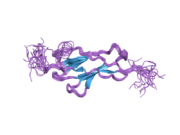| TRIM9 |
|---|
 |
| Available structures |
|---|
| PDB | Ortholog search: PDBe RCSB |
|---|
|
|
| Identifiers |
|---|
| Aliases | TRIM9, RNF91, SPRING, tripartite motif containing 9 |
|---|
| External IDs | OMIM: 606555; MGI: 2137354; HomoloGene: 9045; GeneCards: TRIM9; OMA:TRIM9 - orthologs |
|---|
| Gene location (Human) |
|---|
 | | Chr. | Chromosome 14 (human)[1] |
|---|
| | Band | 14q22.1 | Start | 50,975,262 bp[1] |
|---|
| End | 51,096,061 bp[1] |
|---|
|
| Gene location (Mouse) |
|---|
 | | Chr. | Chromosome 12 (mouse)[2] |
|---|
| | Band | 12|12 C2 | Start | 70,291,307 bp[2] |
|---|
| End | 70,394,388 bp[2] |
|---|
|
| RNA expression pattern |
|---|
| Bgee | | Human | Mouse (ortholog) |
|---|
| Top expressed in | - right hemisphere of cerebellum
- right frontal lobe
- Brodmann area 23
- primary visual cortex
- Brodmann area 9
- Region I of hippocampus proper
- middle temporal gyrus
- ventricular zone
- nucleus accumbens
- caudate nucleus
|
| | Top expressed in | - piriform cortex
- lateral septal nucleus
- Rostral migratory stream
- primary motor cortex
- superior frontal gyrus
- subiculum
- primary visual cortex
- anterior amygdaloid area
- olfactory tubercle
- medial dorsal nucleus
|
| | More reference expression data |
|
|---|
| BioGPS |  | | More reference expression data |
|
|---|
|
| Gene ontology |
|---|
| Molecular function | - metal ion binding
- zinc ion binding
- protein binding
- protein homodimerization activity
- transferase activity
- protein domain specific binding
- ubiquitin-protein transferase activity
- SNARE binding
| | Cellular component | - cytoplasm
- cytoplasmic vesicle
- cell junction
- dendrite
- cell projection
- synapse
- cytoskeleton
- synaptic vesicle
- intracellular anatomical structure
- cytosol
- presynaptic cytosol
| | Biological process | - negative regulation of calcium ion-dependent exocytosis
- protein ubiquitination
- negative regulation of SNARE complex assembly
- synaptic vesicle exocytosis
- proteasome-mediated ubiquitin-dependent protein catabolic process
| | Sources:Amigo / QuickGO |
|
| Orthologs |
|---|
| Species | Human | Mouse |
|---|
| Entrez | | |
|---|
| Ensembl | | |
|---|
| UniProt | | |
|---|
| RefSeq (mRNA) | | NM_001110202
NM_001110203
NM_001286386
NM_001286387
NM_001286388
|
|---|
NM_053167 |
|
|---|
| RefSeq (protein) | | NP_001103672
NP_001103673
NP_001273315
NP_001273316
NP_001273317
|
|---|
NP_444397
NP_001392290
NP_001392291
NP_001392292
NP_001392293
NP_001392294
NP_001392295
NP_001392296
NP_001392297
NP_001392298
NP_001392299
NP_001392300
NP_001392301
NP_001392302
NP_001392303
NP_001392304
NP_001392305
NP_001392306
NP_001392307
NP_001392308
NP_001392309
NP_001392310
NP_001392311
NP_001392312
NP_001392313
NP_001392314
NP_001392315
NP_001392316 |
|
|---|
| Location (UCSC) | Chr 14: 50.98 – 51.1 Mb | Chr 12: 70.29 – 70.39 Mb |
|---|
| PubMed search | [3] | [4] |
|---|
|
| Wikidata |
| View/Edit Human | View/Edit Mouse |
|

 2db8: Solution structures of the fn3 domain of human Tripartite motif protein 9
2db8: Solution structures of the fn3 domain of human Tripartite motif protein 9
















